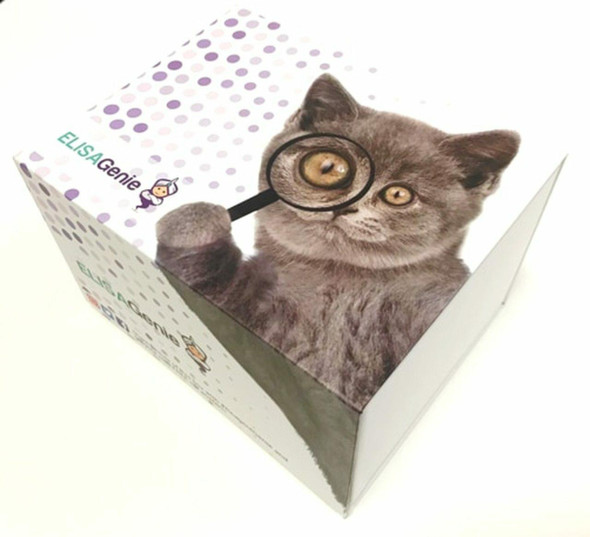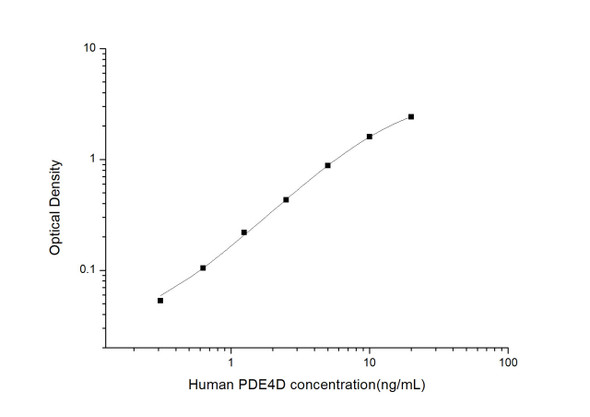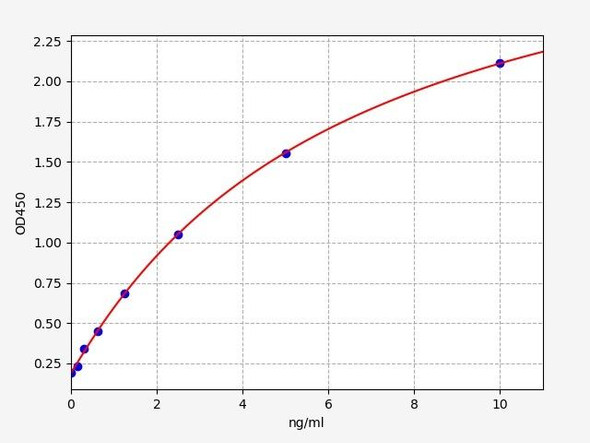Description
Human Phosphodiesterase 4D, cAMP Specific/PDE4D ELISA Kit
The Human Phosphodiesterase 4D (PDE4D) cAMP-specific ELISA Kit is a reliable and accurate tool for the quantitative detection of PDE4D levels in human samples such as serum, plasma, and cell culture supernatants. This kit is highly sensitive and specific, providing consistent and reproducible results for a variety of research applications.PDE4D is a key enzyme involved in the regulation of intracellular cAMP levels, which play a crucial role in various cellular processes including inflammation, cell proliferation, and smooth muscle relaxation.
Dysregulation of PDE4D has been implicated in a variety of diseases including asthma, COPD, and Alzheimer's disease, making it a valuable biomarker for studying these conditions and potential therapeutic interventions.By accurately measuring PDE4D levels, researchers can gain insights into the underlying mechanisms of these diseases and develop targeted therapies to improve patient outcomes. The Human Phosphodiesterase 4D (PDE4D) cAMP-specific ELISA Kit provides a valuable tool for advancing research in these areas.
| Product Name: | Human Phosphodiesterase 4D, cAMP Specific / PDE4D ELISA Kit |
| Product Code: | HUFI02710 |
| Size: | 96 Assays |
| Alias: | PDE4D |
| Detection method: | Sandwich ELISA, Double Antibody |
| Application: | This immunoassay kit allows for the in vitro quantitative determination of Human PDE4D concentrations in serum plasma and other biological fluids. |
| Sensitivity: | 46.875pg/ml |
| Range: | 78.125-5000pg/ml |
| Storage: | 4°C for 6 months |
| Note: | For Research Use Only |
| Recovery: | Matrices listed below were spiked with certain level of Human PDE4D and the recovery rates were calculated by comparing the measured value to the expected amount of Human PDE4D in samples. | ||||||||||||||||
| |||||||||||||||||
| Linearity: | The linearity of the kit was assayed by testing samples spiked with appropriate concentration of Human PDE4D and their serial dilutions. The results were demonstrated by the percentage of calculated concentration to the expected. | ||||||||||||||||
| |||||||||||||||||
| CV(%): | Intra-Assay: CV<8% Inter-Assay: CV<10% |
| Component | Quantity | Storage |
| ELISA Microplate (Dismountable) | 8×12 strips | 4°C for 6 months |
| Lyophilized Standard | 2 | 4°C/-20°C |
| Sample/Standard Dilution Buffer | 20ml | 4°C |
| Biotin-labeled Antibody(Concentrated) | 120ul | 4°C (Protect from light) |
| Antibody Dilution Buffer | 10ml | 4°C |
| HRP-Streptavidin Conjugate(SABC) | 120ul | 4°C (Protect from light) |
| SABC Dilution Buffer | 10ml | 4°C |
| TMB Substrate | 10ml | 4°C (Protect from light) |
| Stop Solution | 10ml | 4°C |
| Wash Buffer(25X) | 30ml | 4°C |
| Plate Sealer | 5 | - |
Other materials and equipment required:
- Microplate reader with 450 nm wavelength filter
- Multichannel Pipette, Pipette, microcentrifuge tubes and disposable pipette tips
- Incubator
- Deionized or distilled water
- Absorbent paper
- Buffer resevoir
| Uniprot | Q08499 |
| UniProt Protein Function: | PDE4D: Hydrolyzes the second messenger cAMP, which is a key regulator of many important physiological processes. Homodimer for the long isoforms. Isoforms with truncated N-termini are monomeric. Isoform 3 is part of a ternary complex containing PRKAR2A, PRKAR2B and AKAP9. Interacts with PDE4DIP. Identified in a complex composed of RYR1, PDE4D, PKA, FKBP1A and protein phosphatase 1 (PP1). Isoform 5, isoform N3 and isoform 12 bind GNB2L1 via their unique N-terminus. Binds ARRB2. Widespread; most abundant in skeletal muscle. Isoform 6 is detected in brain. Isoform 8 is detected in brain, placenta, lung and kidney. Isoform 7 is detected in heart and skeletal muscle. Inhibited by rolipram. Activated by phosphatidic acid. Belongs to the cyclic nucleotide phosphodiesterase family. PDE4 subfamily. 12 isoforms of the human protein are produced by alternative splicing. |
| UniProt Protein Details: | Protein type:EC 3.1.4.53; Nucleotide Metabolism - purine; Phosphodiesterase Chromosomal Location of Human Ortholog: 5q12 Cellular Component: Golgi apparatus; centrosome; myofibril; membrane; apical plasma membrane; voltage-gated calcium channel complex; cytosol Molecular Function:3',5'-cyclic-AMP phosphodiesterase activity; protein binding; enzyme binding; metal ion binding; ubiquitin protein ligase binding; beta-2 adrenergic receptor binding; drug binding; cAMP binding; SH3 domain binding; 3',5'-cyclic-nucleotide phosphodiesterase activity; ATPase binding Biological Process: neutrophil chemotaxis; negative regulation of heart contraction; regulation of heart rate; positive regulation of smooth muscle cell proliferation; multicellular organism growth; cAMP catabolic process; negative regulation of peptidyl-serine phosphorylation; positive regulation of smooth muscle cell migration; T cell receptor signaling pathway; memory; positive regulation of interferon-gamma production; cAMP-mediated signaling; cellular protein complex assembly; smooth muscle contraction; positive regulation of interleukin-2 production; regulation of receptor activity; positive regulation of interleukin-5 production; regulation of G-protein coupled receptor protein signaling pathway; lung development; aging |
| NCBI Summary: | This gene encodes one of four mammalian counterparts to the fruit fly 'dunce' gene. The encoded protein has 3',5'-cyclic-AMP phosphodiesterase activity and degrades cAMP, which acts as a signal transduction molecule in multiple cell types. This gene uses different promoters to generate multiple alternatively spliced transcript variants that encode functional proteins.[provided by RefSeq, Sep 2009] |
| UniProt Code: | Q08499 |
| NCBI GenInfo Identifier: | 12644392 |
| NCBI Gene ID: | 5144 |
| NCBI Accession: | Q08499.2 |
| UniProt Secondary Accession: | Q08499,O43433, Q13549, Q13550, Q13551, Q7Z2L8, Q8IV84 Q8IVA9, Q8IVD2, Q8IVD3, Q96HL4, Q9HCX7, |
| UniProt Related Accession: | Q08499 |
| Molecular Weight: | 809 |
| NCBI Full Name: | cAMP-specific 3',5'-cyclic phosphodiesterase 4D |
| NCBI Synonym Full Names: | phosphodiesterase 4D, cAMP-specific |
| NCBI Official Symbol: | PDE4D |
| NCBI Official Synonym Symbols: | DPDE3; PDE43; STRK1; ACRDYS2; HSPDE4D; PDE4DN2 |
| NCBI Protein Information: | cAMP-specific 3',5'-cyclic phosphodiesterase 4D; cAMP-specific phosphodiesterase PDE4D6; phosphodiesterase 4D, cAMP-specific (phosphodiesterase E3 dunce homolog, Drosophila) |
| UniProt Protein Name: | cAMP-specific 3',5'-cyclic phosphodiesterase 4D |
| UniProt Synonym Protein Names: | DPDE3; PDE43 |
| Protein Family: | cAMP-specific 3',5'-cyclic phosphodiesterase |
| UniProt Gene Name: | PDE4D |
| UniProt Entry Name: | PDE4D_HUMAN |
*Note: Protocols are specific to each batch/lot. For the correct instructions please follow the protocol included in your kit.
Before adding to wells, equilibrate the SABC working solution and TMB substrate for at least 30 min at 37°C. When diluting samples and reagents, they must be mixed completely and evenly. It is recommended to plot a standard curve for each test.
| Step | Protocol |
| 1. | Set standard, test sample and control (zero) wells on the pre-coated plate respectively, and then, record their positions. It is recommended to measure each standard and sample in duplicate. Wash plate 2 times before adding standard, sample and control (zero) wells! |
| 2. | Aliquot 0.1ml standard solutions into the standard wells. |
| 3. | Add 0.1 ml of Sample / Standard dilution buffer into the control (zero) well. |
| 4. | Add 0.1 ml of properly diluted sample ( Human serum, plasma, tissue homogenates and other biological fluids.) into test sample wells. |
| 5. | Seal the plate with a cover and incubate at 37 °C for 90 min. |
| 6. | Remove the cover and discard the plate content, clap the plate on the absorbent filter papers or other absorbent material. Do NOT let the wells completely dry at any time. Wash plate X2. |
| 7. | Add 0.1 ml of Biotin- detection antibody working solution into the above wells (standard, test sample & zero wells). Add the solution at the bottom of each well without touching the side wall. |
| 8. | Seal the plate with a cover and incubate at 37°C for 60 min. |
| 9. | Remove the cover, and wash plate 3 times with Wash buffer. Let wash buffer rest in wells for 1 min between each wash. |
| 10. | Add 0.1 ml of SABC working solution into each well, cover the plate and incubate at 37°C for 30 min. |
| 11. | Remove the cover and wash plate 5 times with Wash buffer, and each time let the wash buffer stay in the wells for 1-2 min. |
| 12. | Add 90 µl of TMB substrate into each well, cover the plate and incubate at 37°C in dark within 10-20 min. (Note: This incubation time is for reference use only, the optimal time should be determined by end user.) And the shades of blue can be seen in the first 3-4 wells (with most concentrated standard solutions), the other wells show no obvious color. |
| 13. | Add 50 µl of Stop solution into each well and mix thoroughly. The color changes into yellow immediately. |
| 14. | Read the O.D. absorbance at 450 nm in a microplate reader immediately after adding the stop solution. |
When carrying out an ELISA assay it is important to prepare your samples in order to achieve the best possible results. Below we have a list of procedures for the preparation of samples for different sample types.
| Sample Type | Protocol |
| Serum | If using serum separator tubes, allow samples to clot for 30 minutes at room temperature. Centrifuge for 10 minutes at 1,000x g. Collect the serum fraction and assay promptly or aliquot and store the samples at -80°C. Avoid multiple freeze-thaw cycles. If serum separator tubes are not being used, allow samples to clot overnight at 2-8°C. Centrifuge for 10 minutes at 1,000x g. Remove serum and assay promptly or aliquot and store the samples at -80°C. Avoid multiple freeze-thaw cycles. |
| Plasma | Collect plasma using EDTA or heparin as an anticoagulant. Centrifuge samples at 4°C for 15 mins at 1000 × g within 30 mins of collection. Collect the plasma fraction and assay promptly or aliquot and store the samples at -80°C. Avoid multiple freeze-thaw cycles. Note: Over haemolysed samples are not suitable for use with this kit. |
| Urine & Cerebrospinal Fluid | Collect the urine (mid-stream) in a sterile container, centrifuge for 20 mins at 2000-3000 rpm. Remove supernatant and assay immediately. If any precipitation is detected, repeat the centrifugation step. A similar protocol can be used for cerebrospinal fluid. |
| Cell culture supernatant | Collect the cell culture media by pipette, followed by centrifugation at 4°C for 20 mins at 1500 rpm. Collect the clear supernatant and assay immediately. |
| Cell lysates | Solubilize cells in lysis buffer and allow to sit on ice for 30 minutes. Centrifuge tubes at 14,000 x g for 5 minutes to remove insoluble material. Aliquot the supernatant into a new tube and discard the remaining whole cell extract. Quantify total protein concentration using a total protein assay. Assay immediately or aliquot and store at ≤ -20 °C. |
| Tissue homogenates | The preparation of tissue homogenates will vary depending upon tissue type. Rinse tissue with 1X PBS to remove excess blood & homogenize in 20ml of 1X PBS (including protease inhibitors) and store overnight at ≤ -20°C. Two freeze-thaw cycles are required to break the cell membranes. To further disrupt the cell membranes you can sonicate the samples. Centrifuge homogenates for 5 mins at 5000xg. Remove the supernatant and assay immediately or aliquot and store at -20°C or -80°C. |
| Tissue lysates | Rinse tissue with PBS, cut into 1-2 mm pieces, and homogenize with a tissue homogenizer in PBS. Add an equal volume of RIPA buffer containing protease inhibitors and lyse tissues at room temperature for 30 minutes with gentle agitation. Centrifuge to remove debris. Quantify total protein concentration using a total protein assay. Assay immediately or aliquot and store at ≤ -20 °C. |
| Breast Milk | Collect milk samples and centrifuge at 10,000 x g for 60 min at 4°C. Aliquot the supernatant and assay. For long term use, store samples at -80°C. Minimize freeze/thaw cycles. |






